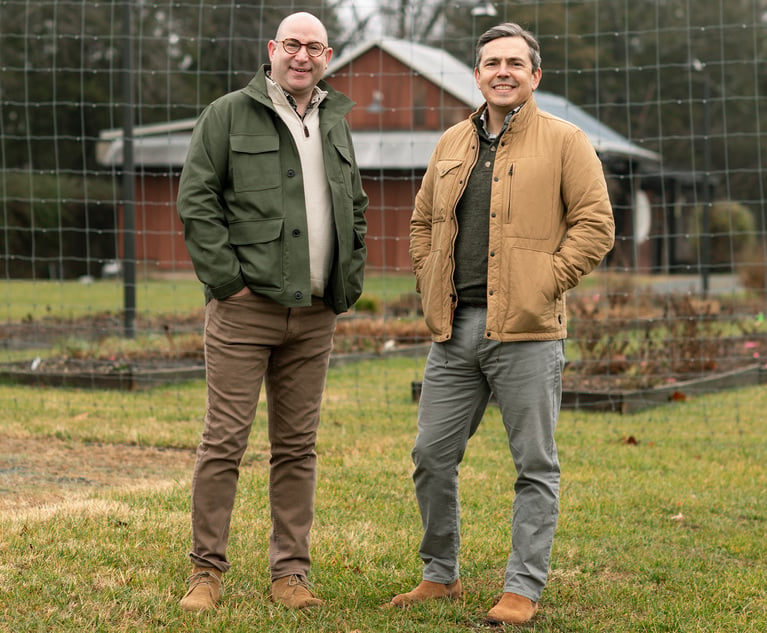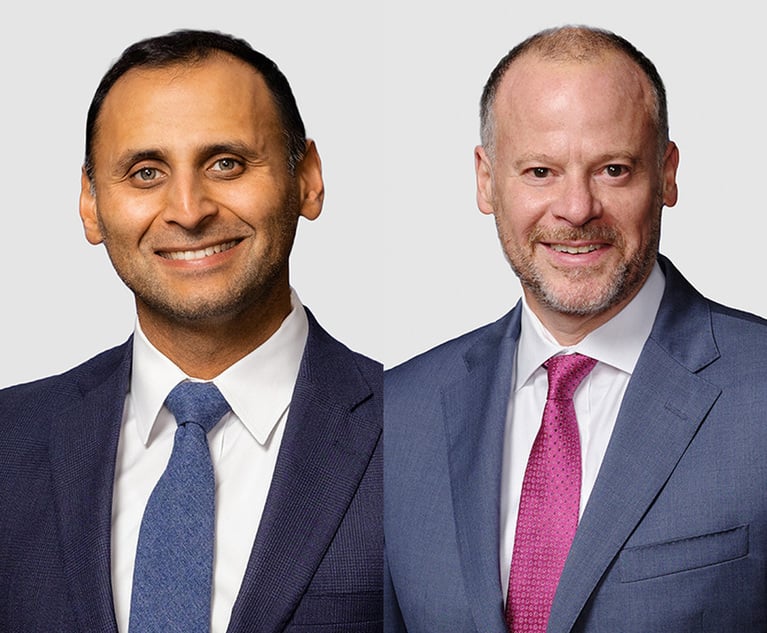Litigators of the Week: A Compassionate—But Effective—Product Liability Defense
When Boehringer Ingelheim was hit with a new wave of suits over its blood thinner Pradaxa, it changed course and decided to fight, tapping Covington & Burling's Phyllis Jones and Butler Snow's Rod Richmond Sr.
May 11, 2018 at 11:35 AM
5 minute read

Four years ago, Boehringer Ingelheim agreed to pay roughly $650 million to settle claims that its blood thinner Pradaxa caused excessive bleeding. But when the pharmaceutical giant was hit with a new wave of Pradaxa suits, Boehringer changed course. This time, it decided to go to court and fight.
The company turned to Covington & Burling's Phyllis Jones, who has racked up a series of wins on behalf of drug companies facing product liability suits, including Eli Lilly and Co.
Along with colleague Paul Schmidt, Jones secured the first victory for Connecticut-based Boehringer on March 23. On Monday, she and Butler Snow's Rod Richmond Sr. notched another win for the defense before a Connecticut state court jury in Hartford.
Jones and Richmond, who had worked together once before, have differing lawyering styles.
Jones describes herself as more laid-back, mellow and to the point while Richmond sees himself as a frank conversationalist with jurors. But both had the same objective: Show the jury they were compassionate about 72-year-old Ohio resident Mary Lou Anne Gallam, who suffered severe bleeding after taking Pradaxa—but also tell the story of the medication, which the Food and Drug Administration approved in 2010 as an anticoagulant used to prevent strokes.
The two experienced litigators did so by focusing on the rigorous approval needed to get the drug on the market.
“The FDA had very closely evaluated and reviewed Pradaxa before approving it in the U.S.,” Jones said. “That included not only the standard FDA review, but also there was an advisory committee where the agency brings in external experts to evaluate the application.”
The question at the time, Jones said, was whether or not the drug should be approved for stroke prevention in patients who have atrial fibrillation. The six-person Hartford jury was made aware that the panel of external experts “shared the view that the FDA reached, and that is the medicine would be an important contributor for doctors treating atrial fibrillation,” she said.
The plaintiffs attorneys' core argument during the six-week trial was that the labeling on the drug was not sufficient. They argued the medicine could cause serious and potentially fatal bleeding. The plaintiff in the first case died, but Gallam recovered.
The strategy to combat the labeling argument, Richmond said, was straightforward: Bring on defense experts to detail the labeling procedures and strongly cross-examine the plaintiff's medical experts.
“All of the witnesses, on both sides, said the warning label regarding bleeding was strong,” said Richmond, who cross-examined the plaintiff's regulatory/pharmacology expert, presented the defense expert cardiologist and delivered the hour-long closing arguments. He said the jury's verdict form unanimously showed his team won the labeling argument.
“They ruled for the defense on the warning label and on the issue of causation, they said there was no negligence on the part of the company that caused the plaintiff's injury.”
Richmond added that showing understanding, compassion and care for Gallam was front and center.
“It's always important for us to be sympathetic to anyone who has suffered any injury, and that sympathy is sincere.” Richmond said. “The plaintiff is a wonderful person and a very nice lady. While we know jurors have natural human emotions that we will not be able to eliminate, at the same time, we need to marshal the relevant facts for the jury's consideration.”
Richmond said he doesn't believe that Pradaxa had anything to do with Gallam's condition, pointing to significant evidence of a pre-existing condition
“She had an abnormality in her colon that began bleeding,” Richmond said. When she went to the hospital, doctors repaired the colon abnormality. “In terms of timing, though, the bleeding event occurred after she had been on Pradaxa for 2 1/2 years. This was not caused by Pradaxa,” he said.
Both attorneys said they had no role in the company prior to a $650 million settlement in May 2014. That settlement, in which Boehringer denied any wrongdoing and said was undertaken to avoid lengthy litigation, resolved roughly 4,000 state and federal cases.
Since that time, the company has been hit with an additional 2,500 lawsuits, most filed in Connecticut. The $650 million settlement did not cover future lawsuits, Jones said, because “that settlement was of a particular grouping of cases that has nothing to do with future cases.”
On Monday, plaintiffs announced that they are giving up on a similar case that was set for trial in early June in California.
“It's often the case when a new medicine is on the market that there is more attention paid to it. You do not see as many lawsuits with older drugs,” Jones said.
This content has been archived. It is available through our partners, LexisNexis® and Bloomberg Law.
To view this content, please continue to their sites.
Not a Lexis Subscriber?
Subscribe Now
Not a Bloomberg Law Subscriber?
Subscribe Now
NOT FOR REPRINT
© 2025 ALM Global, LLC, All Rights Reserved. Request academic re-use from www.copyright.com. All other uses, submit a request to [email protected]. For more information visit Asset & Logo Licensing.
You Might Like
View All
Amid the Tragedy of the L.A. Fires, a Lesson on the Value of Good Neighbors

Why the Founders of IP Boutique Fisch Sigler Are Stepping Away From the Law and Starting an AI Venture

Like a Life Raft: Ben Brafman Reflects on Nearly 50 Years as a Defense Attorney

Trying a Case for Abu Ghraib Detainees Two Decades After Abuse
Trending Stories
Who Got The Work
J. Brugh Lower of Gibbons has entered an appearance for industrial equipment supplier Devco Corporation in a pending trademark infringement lawsuit. The suit, accusing the defendant of selling knock-off Graco products, was filed Dec. 18 in New Jersey District Court by Rivkin Radler on behalf of Graco Inc. and Graco Minnesota. The case, assigned to U.S. District Judge Zahid N. Quraishi, is 3:24-cv-11294, Graco Inc. et al v. Devco Corporation.
Who Got The Work
Rebecca Maller-Stein and Kent A. Yalowitz of Arnold & Porter Kaye Scholer have entered their appearances for Hanaco Venture Capital and its executives, Lior Prosor and David Frankel, in a pending securities lawsuit. The action, filed on Dec. 24 in New York Southern District Court by Zell, Aron & Co. on behalf of Goldeneye Advisors, accuses the defendants of negligently and fraudulently managing the plaintiff's $1 million investment. The case, assigned to U.S. District Judge Vernon S. Broderick, is 1:24-cv-09918, Goldeneye Advisors, LLC v. Hanaco Venture Capital, Ltd. et al.
Who Got The Work
Attorneys from A&O Shearman has stepped in as defense counsel for Toronto-Dominion Bank and other defendants in a pending securities class action. The suit, filed Dec. 11 in New York Southern District Court by Bleichmar Fonti & Auld, accuses the defendants of concealing the bank's 'pervasive' deficiencies in regards to its compliance with the Bank Secrecy Act and the quality of its anti-money laundering controls. The case, assigned to U.S. District Judge Arun Subramanian, is 1:24-cv-09445, Gonzalez v. The Toronto-Dominion Bank et al.
Who Got The Work
Crown Castle International, a Pennsylvania company providing shared communications infrastructure, has turned to Luke D. Wolf of Gordon Rees Scully Mansukhani to fend off a pending breach-of-contract lawsuit. The court action, filed Nov. 25 in Michigan Eastern District Court by Hooper Hathaway PC on behalf of The Town Residences LLC, accuses Crown Castle of failing to transfer approximately $30,000 in utility payments from T-Mobile in breach of a roof-top lease and assignment agreement. The case, assigned to U.S. District Judge Susan K. Declercq, is 2:24-cv-13131, The Town Residences LLC v. T-Mobile US, Inc. et al.
Who Got The Work
Wilfred P. Coronato and Daniel M. Schwartz of McCarter & English have stepped in as defense counsel to Electrolux Home Products Inc. in a pending product liability lawsuit. The court action, filed Nov. 26 in New York Eastern District Court by Poulos Lopiccolo PC and Nagel Rice LLP on behalf of David Stern, alleges that the defendant's refrigerators’ drawers and shelving repeatedly break and fall apart within months after purchase. The case, assigned to U.S. District Judge Joan M. Azrack, is 2:24-cv-08204, Stern v. Electrolux Home Products, Inc.
Featured Firms
Law Offices of Gary Martin Hays & Associates, P.C.
(470) 294-1674
Law Offices of Mark E. Salomone
(857) 444-6468
Smith & Hassler
(713) 739-1250






